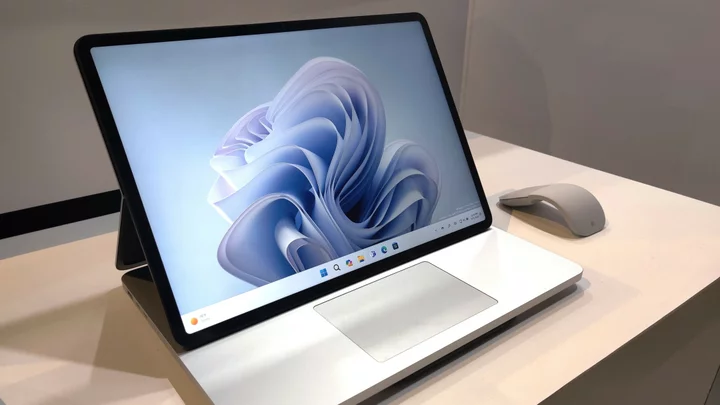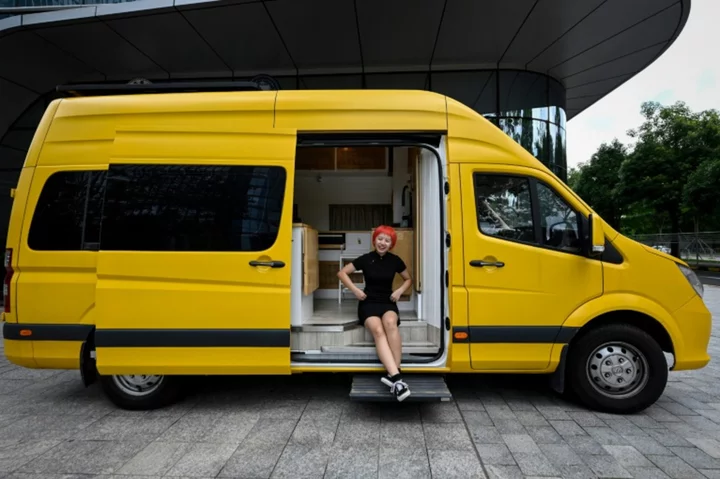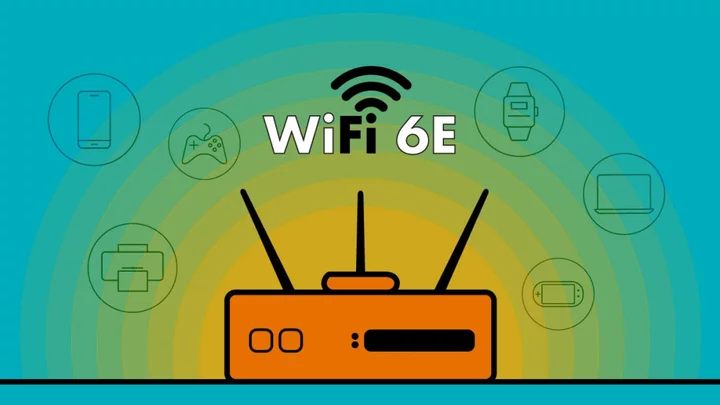Microsoft Copilot was, by far, the star of the Microsoft event in New York on Sept. 21. It’s coming to everything Microsoft, in myriad ways and forms. The Surface hardware that Redmond decloaked was a sideshow, and perhaps a tad subdued with the departure of Panos Panay, Microsoft’s animated chief of the Surface world.
But the flexible flagship Surface Laptop for creators, the Surface Laptop Studio, did see some interesting enhancements in its 2023 Studio 2 incarnation, introduced today and opening for pre-orders. These include the surprise addition of an Intel Movidius discrete neural processor, designed for powering local AI tasks, alongside updated core components, more ports and slots, and a whole new chassis build.
Microsoft Surface Laptop Studio 2
What Does This ‘Movidius’ Stuff Mean?
We covered earlier this week the disclosures around Intel’s “Meteor Lake” processor line and the debut of the new Core Ultra family of CPUs, expected to hit premium laptops by the end of the year. But interestingly, the new Surface top dog will not feature one of these cutting-edge processors, which are slated to debut December 14. Instead, it will employ a 13th Gen Core H-series “Raptor Lake” processor, the Core i7-13700H, and alongside it a separate NPU, or neural processing engine, dubbed the Movidius 3700VC, a discrete chip from Intel.
This is an interesting development, in that the soon-coming Intel Meteor Lake chips will integrate an NPU with the CPU, as part of one of the “chiplets” that comprise the new generation of Intel processors. It’s not the first appearance of an dedicated AI processor in a Surface device, mind you; those honors go to the Qualcomm Arm SQ3 version of the Surface Pro 9 that debuted around a year ago. But it’s notable that here it’s a discrete AI chip, not part of the processor. It shows up in Task Manager as a discrete resource, as you can see here...
(Credit: John Burek)A Surface rep onsite at the New York event noted that Microsoft didn’t want to wait for the new generation of AI-integrated Intel Core Ultra chips to refresh the Surface Laptop Studio, which was getting a little long in the tooth given its 2021 launch date. But how could the top Surface laptop roll into 2024 without an AI hardware-processing story to tell, given the AI-oriented enhancements built into new-gen mobile processors from Intel and AMD alike? And so, we have the Surface Laptop Studio 2, rocking a “Raptor Lake”-class chip and Movidius.
First, the Hardware: Still a Flipping Studio
At first glance, the Surface Laptop Studio 2 hasn’t changed radically on the outside from the previous-generation Studio. But once you look closer, you’ll see it has been given the biggest revamp of the late-2023 Surface reboots.
The flip-and-fold screen design is the same as with the previous generation, and the sample units that we manipulated onsite had the same “catch”-iness to the folding action; you have really give the screen a bit of an uncomfortable yank in the right spot to separate the magnet grip from the lid and start the unfolding action, and you need to use two hands.
(Credit: John Burek)The screen does snap to a midpoint with accuracy, covering just the keyboard and leaving the haptic touchpad exposed, in a touch-friendly gyration Microsoft calls “Stage mode.” It’s ideal for watching media or penning around. The panel then folds flat if you keep pulling it toward you, covering the keyboard and touchpad. The whole works is chunky in tablet mode, though, best used flat on the desk with the accessory pen or your fingertip, than hefted in your hand like an iPad.
(Credit: John Burek)Our onsite Microsoft rep demonstrating the unit was keen to point out a sort of "shy taskbar" mode, in which the conventional Windows taskbar autohides in tablet mode, though you can restore it with a simple swipe-up...
(Credit: John Burek)The Surface Slim Pen 2 parks under the front edge of the laptop and grips there magnetically to charge. As before, it’s an extra-cost add-on. We’ve used the flat-sided Slim Pen before, and the grip takes some getting used to, but we personally prefer it to the slicker cylinder of the vanilla Surface Pen.
(Credit: John Burek) (Credit: John Burek)The keyboard has good snap to the keys, and Microsoft touts improvements to the haptic feedback of the touch pad. The haptic feedback means this is not a mechanical-click, tilting pad. Our left- and right-clicks were convincing nonetheless, making us look closely at the pad leveling to see that it really wasn’t depressing into the chassis when we tapped.
We spent some time onsite with the GeForce RTX 4060-based version of the Surface Laptop Studio 2. (The company will also offer RTX 4050 and integrated-graphics Intel Iris Xe versions, as well as one SKU with pro-grade Nvidia RTX 2000 Ada graphics for engineers, designers, and the like.) Microsoft was demonstrating the machine with Cyberpunk 2077’s latest DLC, Phantom Liberty, an early adopter of Nvidia’s spanking-new DLSS 3.5 tech. We saw and engaged a bit with the demo, with the game running at 1,600 by 1,200 with DLSS 3.5 activated, playing with a Xbox controller and the screen parked in Stage mode. (One of the reps we spoke with noted that the screen in this orientation allows for slightly higher thermal tolerances for the CPU and GPU.)
(Credit: John Burek)Frame rates were smooth (our rep claimed he achieved sustained rates above 60fps at the demonstrated settings), and he scrupulously pointed out the exceptional detail in puddles and other reflective surfaces enabled by a DLSS 3.5 ray-tracing technique Nvidia calls “Ray Reconstruction.” (To which we quipped, of course: “Poor Ray. What happened to him?”) DLSS 3.5 also layers in frame generation and super-scaling features from earlier versions of DLSS.
Of course, gaming on the the Surface Laptop Studio 2 is mainly a side quest on a laptop like this. This machine is more about creative tasks done in the screen orientation most conducive to the moment and the job at hand. For designers and graphics/video editors, Microsoft has added a microSD card slot to the right edge of the machine (a natural fit for the Studio’s content- and media-creator user base). The previous Studio model had just two Thunderbolt 4-enabled USB Type-C ports; those return here, but Microsoft added a classic Type-A on the left edge alongside them, hewing to popular demand. (We applaud that; A ain’t dead yet.)
(Credit: John Burek) (Credit: John Burek)The chassis has also gotten an all-out materials revamp, even though it is largely shaped the same. Anodized aluminum is now the order of the day, lending a bit more of a premium feel; the previous magnesium alloy was certainly no slouch, but it actually looked and felt less like metal than this model’s skin.
(Credit: John Burek)One of the coolest creature comforts, though, comes down to the camera above the screen. The field of view has been widened to 110 degrees, and the toggle-able conferencing features that Microsoft is incorporating under the umbrella of Windows Studio Effects are the most tangible gains that make use of the Movidius NPU.
Windows Studio Effects: The Big First NPU Beneficiaries
Now, a few ancillary creature comforts centered on videoconferencing might not seem like much to write home about. But maybe you’ve spent the last three or so years working from home or in a hybrid situation, struggling to maintain eye contact with your boss in Microsoft Teams (or the conferencing client of your choice). Or maybe you’ve tried masking the mess in your home office with a hokey Hawaii faux-backdrop, or a janky blur effect. If so, you’ll appreciate much of what Studio Effects aims to do.
(Credit: John Burek)We were impressed with Studio Effects, even if its palette of options is limited. A rep demonstrated a pop-down menu in Teams, which lets you toggle three key effects. The first is background blur, which takes the load off the CPU when rendering blur in realtime. If you’re presenting or doing other demanding tasks while in a video call, the NPU can handle the realtime jiggery-pokery without compromising performance. The camera autodetected faces in the video image well, and it blurred out folks nearby who had their backs turned or who were facing away.
Second is eye-contact correction. That’s not a world's-first feature, and it’s subtle, but this kind of thing is processing-intensive. It adjusts your gaze in real time to the actual position of the camera, even if you’re looking offscreen at your second monitor while reading notes, or trying to adjust to an awkward screen/camera juxtaposition.
Third is most striking: a dynamic field-of-view and reframing function enabled by the AI. The wider-view camera can refocus and reframe your face as you adjust the screen or move around in the viewing space. The camera can also auto-reframe if another party joins the conversation alongside you, tweaking the framing to accommodate both of you in the picture, and reconfiguring if one of you steps away. It reduces the cognitive load of “keeping up appearances” while you engage in a video call, letting you concentrate on the discussion at hand.
The Spec Loadout
In addition to the aforementioned GPU options and the Movidius AI accelerator, the Surface Laptop Studio 2’s base version will come with an Intel Core i7-13700H processor (the same CPU comes in all variants, though commercial models get the security-minded Core i7-13800H), 16GB of memory, and a 512GB PCI Express NVMe Gen 4.0 SSD. Memory can be bumped up to 32GB or 64GB, while storage can be increased to 1TB or 2TB SSDs. The sole Nvidia RTX 2000 pro-graphics model will feature 32GB of DDR5 and a 1TB SSD.
The processor is certainly an improvement over the 11th Generation Core i5 in the original Surface Laptop Studio. It’s nice to see a Core i7 in the entry-level and all other configurations this time. When we tested the Core i7 version of the original Surface Laptop Studio, though, we found its performance to be somewhat lacking. The original also had a smaller 256GB SSD in the base configuration. We’ll have to see how the CPU and GPU thermal handling shakes out in our lab tests once we get the new Studio 2 in hand.
(Credit: John Burek)All versions of the Surface Laptop Studio 2 come with the same 14.4-inch PixelSense flip-and-fold screen. It’s got a resolution of 2,400 by 1,600 pixels, a dynamic refresh rate up to 120Hz, and a contrast ratio of 1,500:1. Brightness tops out at a rated 500 nits for SDR and 650 nits for HDR.
One last note for this generation: Microsoft has emphasized a push toward replaceable parts. Now, that doesn’t mean your average consumer should plan to whip out a screwdriver and swap SSDs or screens (though if it’s out of warranty, that may be an option you want to pursue), but it’s possible. This initiative is geared more toward authorized repair facilities having access to the parts required to make fixes. Screws under the feet on the Laptop Studio 2’s underside afford much easier interior access than some earlier Surfaces, which could be gluey nightmares to get inside of. According to Microsoft, it should be possible to swap out the SSD, the display, various cosmetic plates, the port and connector modules, and even the whole motherboard.
(Credit: John Burek)We’re looking forward to taking the new Studio 2 for a spin and getting it under the PC Labs testing microscope, especially the battery life, which Microsoft posits as 16 to 19 hours depending on the GPU and SSD configuration. Watch for a review soon on PCMag,com.









